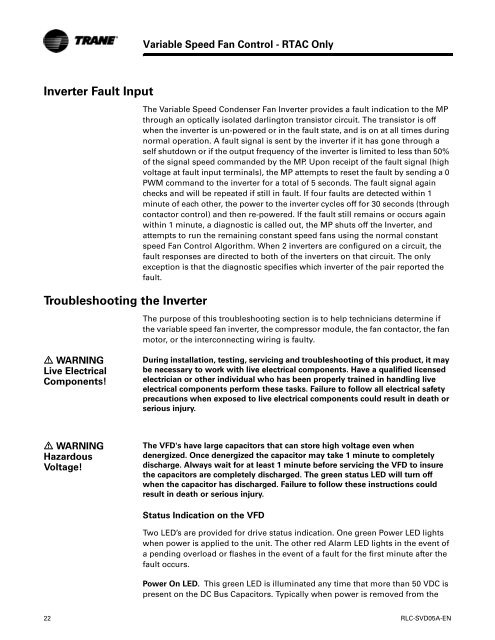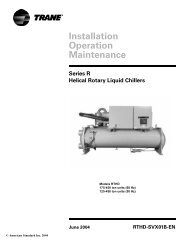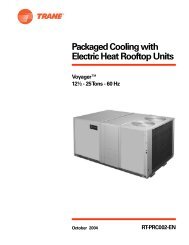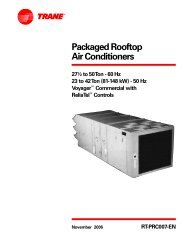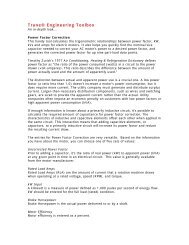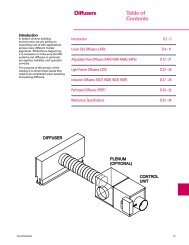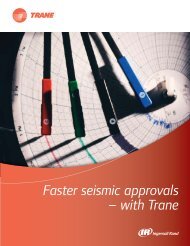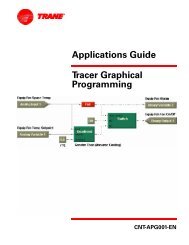RTHD and RTAC - Trane
RTHD and RTAC - Trane
RTHD and RTAC - Trane
You also want an ePaper? Increase the reach of your titles
YUMPU automatically turns print PDFs into web optimized ePapers that Google loves.
Inverter Fault Input<br />
Troubleshooting the Inverter<br />
� WARNING<br />
Live Electrical<br />
Components!<br />
� WARNING<br />
Hazardous<br />
Voltage!<br />
Variable Speed Fan Control - <strong>RTAC</strong> Only<br />
The Variable Speed Condenser Fan Inverter provides a fault indication to the MP<br />
through an optically isolated darlington transistor circuit. The transistor is off<br />
when the inverter is un-powered or in the fault state, <strong>and</strong> is on at all times during<br />
normal operation. A fault signal is sent by the inverter if it has gone through a<br />
self shutdown or if the output frequency of the inverter is limited to less than 50%<br />
of the signal speed comm<strong>and</strong>ed by the MP. Upon receipt of the fault signal (high<br />
voltage at fault input terminals), the MP attempts to reset the fault by sending a 0<br />
PWM comm<strong>and</strong> to the inverter for a total of 5 seconds. The fault signal again<br />
checks <strong>and</strong> will be repeated if still in fault. If four faults are detected within 1<br />
minute of each other, the power to the inverter cycles off for 30 seconds (through<br />
contactor control) <strong>and</strong> then re-powered. If the fault still remains or occurs again<br />
within 1 minute, a diagnostic is called out, the MP shuts off the Inverter, <strong>and</strong><br />
attempts to run the remaining constant speed fans using the normal constant<br />
speed Fan Control Algorithm. When 2 inverters are configured on a circuit, the<br />
fault responses are directed to both of the inverters on that circuit. The only<br />
exception is that the diagnostic specifies which inverter of the pair reported the<br />
fault.<br />
The purpose of this troubleshooting section is to help technicians determine if<br />
the variable speed fan inverter, the compressor module, the fan contactor, the fan<br />
motor, or the interconnecting wiring is faulty.<br />
During installation, testing, servicing <strong>and</strong> troubleshooting of this product, it may<br />
be necessary to work with live electrical components. Have a qualified licensed<br />
electrician or other individual who has been properly trained in h<strong>and</strong>ling live<br />
electrical components perform these tasks. Failure to follow all electrical safety<br />
precautions when exposed to live electrical components could result in death or<br />
serious injury.<br />
The VFD's have large capacitors that can store high voltage even when<br />
denergized. Once denergized the capacitor may take 1 minute to completely<br />
discharge. Always wait for at least 1 minute before servicing the VFD to insure<br />
the capacitors are completely discharged. The green status LED will turn off<br />
when the capacitor has discharged. Failure to follow these instructions could<br />
result in death or serious injury.<br />
Status Indication on the VFD<br />
Two LED’s are provided for drive status indication. One green Power LED lights<br />
when power is applied to the unit. The other red Alarm LED lights in the event of<br />
a pending overload or flashes in the event of a fault for the first minute after the<br />
fault occurs.<br />
Power On LED. This green LED is illuminated any time that more than 50 VDC is<br />
present on the DC Bus Capacitors. Typically when power is removed from the<br />
22 RLC-SVD05A-EN


